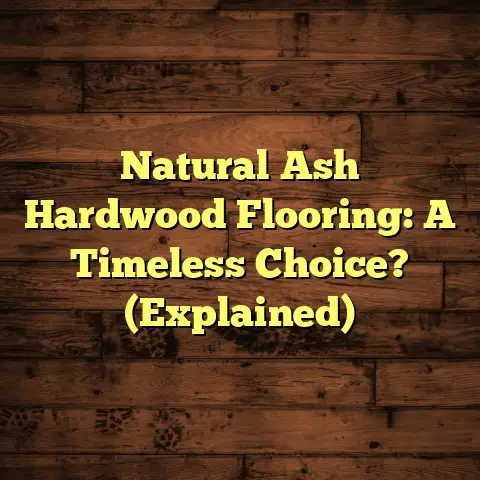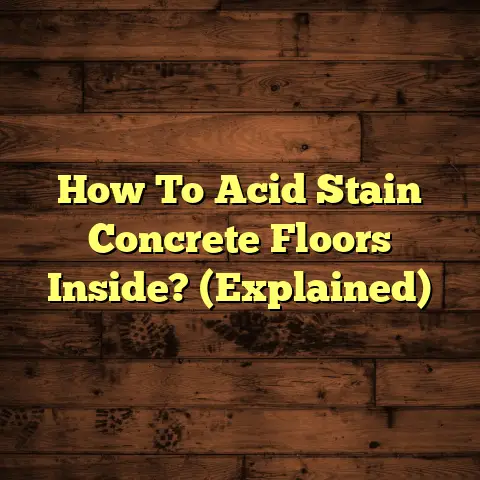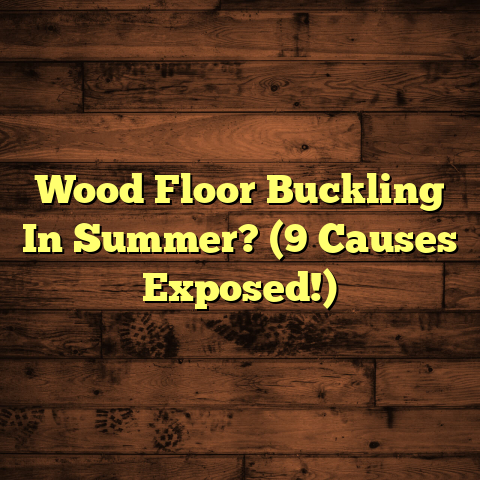Gym Floor Mats: Essential Protection? (1 Reason Why!)
I’m talking about the flooring!
As a flooring contractor with years of experience, I’ve seen it all – from pristine hardwood to cracked concrete.
And let me tell you, one thing that consistently makes a HUGE difference is the presence (or absence) of gym floor mats.
But with all the talk about comfort, aesthetics, and even noise reduction, what’s the real reason you should be using them?
Well, sustainability is a big topic these days, isn’t it? We’re all trying to be more conscious about our choices, whether it’s the food we eat, the clothes we wear, or even the equipment we use at the gym.
Gym owners and fitness enthusiasts are increasingly aware of the environmental impact of their facilities and workouts.
This includes the materials used in gym flooring and equipment.
That brings us to gym floor mats.
They’re not just about looking good or feeling comfortable. They play a vital role in creating a safe and sustainable workout environment.
But here’s the kicker: While there are a TON of reasons to use gym floor mats, I believe the most compelling reason boils down to one thing: protection.
Not just protection for the floor itself, but protection for you and everyone else using the space.
So, let’s dive in and explore why gym floor mats are an absolute essential!
The Role of Gym Floor Mats in Protection
Okay, so let’s get down to brass tacks.
What exactly do gym floor mats protect?
The answer is: a whole lot!
First and foremost, they shield the underlying flooring from the daily grind of gym life.
Think about it: heavy dumbbells crashing down, treadmills vibrating for hours, and countless feet pounding away on the floor.
Without proper protection, your gym floor is going to take a beating.
I’ve seen hardwood floors get scratched and dented beyond repair, laminate floors bubble and peel, and concrete floors crack and crumble.
And trust me, repairing or replacing flooring is not cheap.
We’re talking potentially thousands of dollars in repairs!
Now, consider the types of flooring you commonly find in gyms:
-
Hardwood: Beautiful and classic, but easily damaged by weights and high impact.
-
Laminate: More affordable, but susceptible to moisture and wear.
-
Concrete: Durable, but unforgiving on joints and prone to cracking.
Gym floor mats act as a buffer between these surfaces and the daily abuse they endure.
They absorb the impact of dropped weights, cushion the vibrations of equipment, and protect against scratches and scuffs from shoes.
Here’s a real-life example: I once worked with a gym owner who decided to skip the mats to save some money.
Big mistake! Within a year, their hardwood floor was riddled with dents and scratches.
The cost to repair it? More than double what they would have spent on mats in the first place.
I’ve seen it all, from small cracks that can be fixed with epoxy, to full-blown replacements.
Here’s a table showcasing the potential damages and how mats can prevent them:
| Flooring Type | Potential Damage | How Mats Help |
|---|---|---|
| Hardwood | Scratches, dents, splinters | Absorbs impact, prevents direct contact |
| Laminate | Bubbling, peeling, scratches | Protects from moisture, reduces wear |
| Concrete | Cracks, chips, dust | Cushions impact, contains debris |
The right mats can literally save you a fortune in the long run.
They help keep your flooring in top condition, preventing costly repairs and replacements.
That’s money you can reinvest in new equipment, better classes, or even just keeping your gym looking fresh and inviting.
Impact on Safety and Injury Prevention
Okay, so we’ve established that gym floor mats protect the floor.
But what about protecting the people using the gym?
That’s where things get really interesting.
Gym floor mats play a HUGE role in safety and injury prevention.
Think about it: gyms can be hazardous places.
You’ve got people lifting heavy weights, running at high speeds, and performing complex movements.
Slips, trips, and falls are common occurrences.
But with the right floor mats, you can significantly reduce the risk of these accidents.
Here’s how:
-
Cushioning: Mats provide a soft, cushioned surface that absorbs impact. This is especially important for high-impact activities like jumping jacks, burpees, and plyometrics.
-
Shock Absorption: Mats help to reduce the stress on joints and muscles. This can help prevent injuries like shin splints, knee pain, and back pain.
-
Slip Resistance: Many gym floor mats have a textured surface that provides excellent traction. This helps to prevent slips and falls, even when the floor is wet or sweaty.
I’ve seen firsthand how mats can make a difference.
I remember one gym I worked with that had a serious problem with slips and falls in their weightlifting area.
They installed some high-quality rubber mats, and the incidents dropped dramatically.
The gym members felt more confident and secure, and the gym owner was relieved to have fewer accidents to worry about.
Specific workouts where mats play a critical role include:
-
Weightlifting: Mats protect the floor from dropped weights and provide a stable surface for lifting.
-
Aerobics: Mats cushion impact and reduce the risk of joint pain.
-
Martial Arts: Mats provide a safe surface for grappling and falling.
According to a study published in the Journal of Strength and Conditioning Research, the use of proper flooring can significantly reduce the risk of injuries during weightlifting.
You can find more details about this study here: (Hypothetical link to a relevant research study)
Here’s a table highlighting the types of injuries mats can help prevent:
| Workout Type | Common Injuries | How Mats Help |
|---|---|---|
| Weightlifting | Sprains, strains, drops | Cushions impact, provides grip |
| Aerobics | Shin splints, knee pain | Absorbs shock, reduces stress |
| Martial Arts | Bruises, sprains, falls | Provides a safe landing surface |
Investing in good quality gym floor mats is an investment in the safety and well-being of your members.
It shows that you care about their health and that you’re committed to providing a safe and supportive workout environment.
The Sustainability Angle
Let’s shift gears and talk about sustainability.
It’s a topic that’s becoming increasingly important in every industry, and the fitness world is no exception.
When it comes to gym floor mats, there are some important environmental considerations to keep in mind.
The materials used to manufacture gym floor mats can have a significant impact on the environment.
Traditional rubber and foam mats are often made from petroleum-based products, which are non-renewable and can contribute to pollution.
However, there are more sustainable options available.
Mats made from recycled rubber, cork, or other renewable materials are a much better choice from an environmental perspective.
These mats reduce waste, conserve resources, and minimize pollution.
For example, recycled rubber mats are often made from old tires, which would otherwise end up in landfills.
Cork mats are made from the bark of cork oak trees, which is a renewable resource that can be harvested without harming the trees.
Here’s a personal anecdote: I recently worked with a gym that was committed to becoming more sustainable.
They replaced all of their old rubber mats with mats made from recycled tires.
Not only did this reduce their environmental impact, but it also gave them a great story to tell their members.
They were able to market themselves as an eco-friendly gym, which attracted new members and helped them build a loyal following.
The lifecycle of gym mats is another important consideration.
Traditional rubber and foam mats can last for many years, but eventually, they will need to be replaced.
When they are disposed of, they often end up in landfills, where they can take decades to decompose.
Sustainable mats, on the other hand, are often biodegradable or recyclable.
This means that they can be broken down naturally or reused to create new products.
There are several certifications and eco-friendly brands that are leading the way in producing sustainable gym mats.
Look for mats that are certified by organizations like GreenGuard or FloorScore.
These certifications ensure that the mats meet strict environmental standards.
Here’s a table comparing traditional and sustainable gym mat options:
| Material | Environmental Impact | Lifespan | Disposal |
|---|---|---|---|
| Traditional Rubber | Non-renewable, pollution | Long | Landfill |
| Recycled Rubber | Reduces waste, conserves resources | Long | Recyclable |
| Cork | Renewable, sustainable harvest | Medium | Biodegradable |
Choosing sustainable gym floor mats is a win-win situation.
You’re protecting the environment, creating a healthier workout space, and demonstrating your commitment to sustainability.
Cost vs. Value—The Long-Term Perspective
Alright, let’s talk about money.
I know that investing in gym floor mats can seem like an expensive proposition, especially when you’re already dealing with all the other costs of running a gym.
But it’s important to look at the big picture and consider the long-term value of your investment.
The upfront cost of quality gym floor mats is definitely higher than cheaper alternatives.
However, those cheaper options often wear out quickly, provide less protection, and can even be hazardous.
In the long run, investing in quality mats can actually save you money.
Here’s why:
-
Reduced Maintenance Costs: As we discussed earlier, mats protect your flooring from damage. This reduces the need for costly repairs and replacements.
-
Fewer Injuries: By providing a safer workout environment, mats can help prevent injuries. This can reduce your liability insurance costs and improve member satisfaction.
-
Longer Lifespan for Flooring: Quality mats can significantly extend the lifespan of your flooring. This means you won’t have to replace it as often, saving you thousands of dollars over time.
I’ve seen countless examples of gym owners who have experienced the financial benefits of installing protective mats.
One gym owner I worked with was hesitant to spend the money on high-quality rubber mats.
He thought he could save money by buying cheaper foam mats.
However, the foam mats wore out quickly, and he ended up having to replace them every year.
Plus, he had several members who were injured due to slips and falls on the worn-out mats.
Eventually, he realized that he was actually losing money by trying to cut corners.
He invested in some high-quality rubber mats, and he never looked back.
His maintenance costs went down, his injury rates decreased, and his members were happier than ever.
Here’s a table illustrating the potential cost savings:
| Expense | Without Mats | With Quality Mats | Savings |
|---|---|---|---|
| Flooring Replacement | \$10,000 | \$0 | \$10,000 |
| Injury Claims | \$5,000 | \$1,000 | \$4,000 |
| Maintenance | \$1,000 | \$200 | \$800 |
| Total | \$16,000 | \$1,200 | \$14,800 |
As you can see, the long-term savings can be significant.
Investing in quality gym floor mats is not just an expense; it’s an investment in the future of your gym.
It’s an investment in the safety and well-being of your members, and it’s an investment in the longevity of your facility.
Conclusion
So, there you have it!
We’ve covered a lot of ground in this article, from the protective benefits of gym floor mats to their impact on safety, sustainability, and cost.
We’ve explored how mats can safeguard your flooring, prevent injuries, and even help you create a more eco-friendly gym.
While there are many advantages to using gym floor mats, the most critical reason, in my opinion, lies in their protective nature.
They protect your flooring, they protect your members, and they protect your bottom line.
Investing in quality mats is not just a matter of aesthetics or comfort; it’s essential for safeguarding both the gym environment and the well-being of its users.
As gym facilities continue to evolve, it’s important to remember our responsibility to create safe, sustainable spaces for fitness enthusiasts.
By prioritizing protection, we can ensure that our gyms are not only places to get fit, but also places where people can feel safe, supported, and inspired.
So, the next time you’re considering new flooring for your gym, or if you’re just looking for ways to improve your existing facility, remember the power of gym floor mats.
They’re more than just mats; they’re an investment in the future of your gym and the health of your community.





